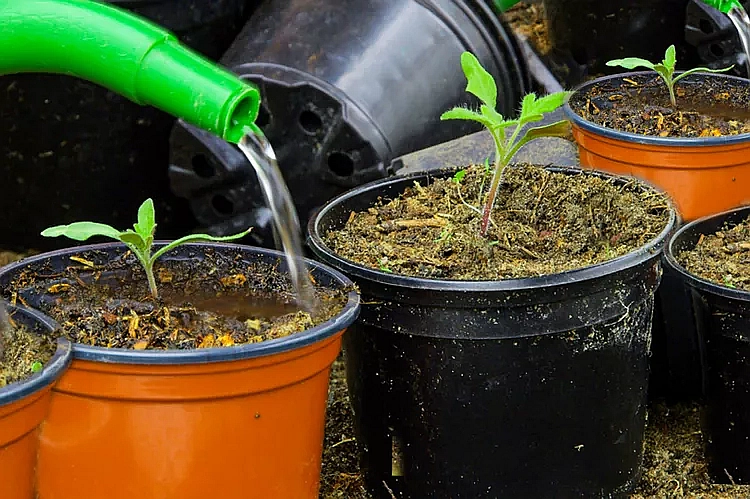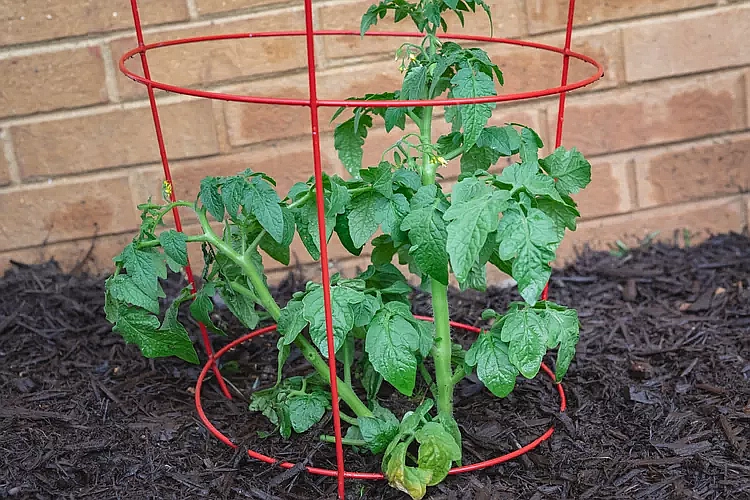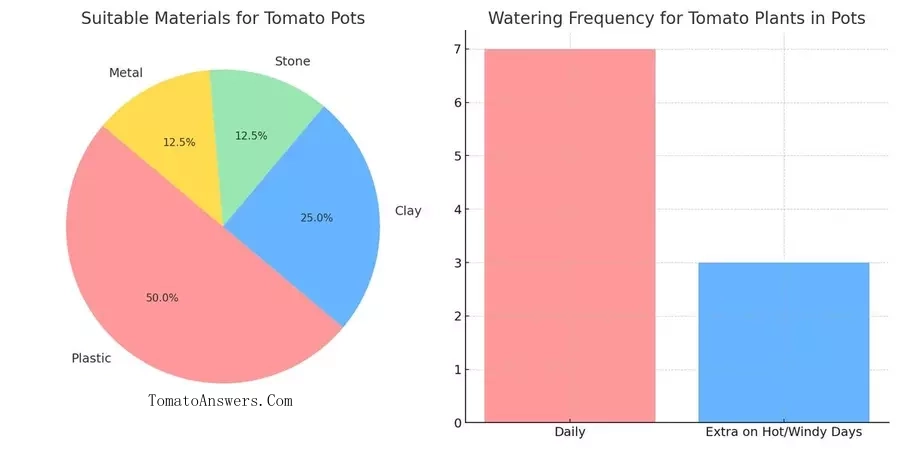Even without a garden, you can still enjoy the delight of harvesting your juicy tomatoes. Pots or containers make it possible to grow these red beauties on your deck, patio, or balcony.
While potted tomatoes need more attention due to limited water and nutrients than those in the garden, the results are just as rewarding. You’ll be rewarded with a bountiful harvest of tasty tomatoes with the right care.
Read on for 10 essential tips to successfully grow tomatoes in pots.
1. Plant A Patio Or Bush Tomato Variety.
Even the smallest tomato plants can surprise you with their bountiful harvest. Patio or bush varieties are specially adapted to thrive in containers. These compact plants, growing only 1 to 3 feet tall, are engineered to fruit abundantly despite their size.
Each season, new and improved varieties join the ranks of favorites like ‘Patio Choice Yellow,’ ‘Tumbler,’ ‘Bush Early Girl,’ ‘Pixie,’ ‘Tiny Tim’, and ‘Small Fry,’ offering a world of options for the aspiring tomato grower.
2. Choose a BIG pot.
Tomatoes love space and their roots are no exception. A spacious container ensures the roots have ample room to grow, absorbing nutrients and water.
Aim for pots that hold at least 5 gallons of soil and are 20 inches wide. Even a 5-gallon bucket can become a cozy home for your tomatoes with the simple addition of drainage holes at the bottom.
3. Drainage Is Key
While tomatoes are not picky about the material of the pots they grow in, good drainage is non-negotiable. Whether plastic, clay, stone, or metal, ensure your pot has adequate drainage holes. This allows excess water to escape, preventing the roots from sitting in water and avoiding issues like root rot.
4. Use Potting Mix
Garden soil might seem convenient, but it’s not ideal for potted tomatoes. A high-quality potting mix at your local garden center is specially formulated to provide the right texture and nutrient content for optimal drainage and growth.
5. Fertilize Your Plants
Feeding your tomato plants is essential for a healthy harvest. Start with a slow-release fertilizer designed for vegetables at planting time.
Since potting mix tends to drain quickly, and along with it, a follow-up dose of fertilizer after four to six weeks ensures your plants don’t starve. You can choose organic options like fish emulsion, greensand, or kelp meal to keep them well-nourished.
6. Give Tomato Plants Plenty Of Sunlight
Sunlight is a tomato plant’s best friend. Ensure your plants receive at least 8 hours of sunlight daily to promote healthy growth and fruiting. Positioning them on the south or west side of a building ensures they soak up the most direct rays, supporting their journey from tiny seedlings to fruitful plants.
7. Water Tomato Plants In Pots Daily
Tomato plants have a healthy thirst, particularly as they grow bigger. A daily watering schedule keeps them happy and hydrated. Extra morning and late afternoon water ensures they stay vibrant on those scorching or windy days.
Deep watering that allows excess moisture to escape through the drainage holes is the key to preventing wilt and promoting growth.
8. Keep Leaves Dry
Diseases often find their way to tomato plants when their leaves are wet. Water the plants at their base to mitigate this, steering clear of the leaves. If using a hose or watering can, adjust the pressure and angle to ensure the soil and water don’t splash up, keeping the leaves dry and disease-free.
9. Give Plants Space
The breathing room is not just for people; tomato plants love it, too! Ensuring adequate space between your plants promotes air circulation, which helps to dry the foliage quickly and reduces the risk of diseases.
Arrange your plants carefully, ensuring leaves can stretch without touching walls or neighboring plants.
10. Provide Support For Potted Tomato Plants
As tomato fruits ripen, they gain weight, and stems can bend or break without proper support. Secure your plants by adding a cage or stake to the pot when planting.
As they grow, gently weave the stems through the trellis or tie them to the stake, offering the needed support for a hearty and safe harvest.
11. Monitoring For Potted Tomato Plants
Keep an eye on your tomato plants as they grow. Watch out for any signs of diseases or pests. If spotted, address the issue promptly with natural remedies or seek advice from a local garden center.
12. Harvesting For Potted Tomato Plants
Harvest your tomatoes when fully colored and slightly soft to the touch. Enjoy fresh fruits of your labor, salads, or any recipe for a burst of tomato flavor.
How To Grow Tomatoes In Containers, Pots Or Buckets (Container Gardening) Video Tips
FAQs about Growing Tomato Plants in Pots
How often should I water my potted tomato plants?
Water them daily and adjust the frequency depending on the weather conditions; more frequent watering may be needed during hot or windy days.
What type of fertilizer is best for potted tomatoes?
A slow-release fertilizer specifically designed for vegetables works well. Organic options like fish emulsion or kelp meal are also effective.
How do I know when my tomatoes are ready to harvest?
Harvest tomatoes when they are fully colored and slightly soft to the touch.
Can I grow tomatoes in pots indoors?
Yes, they receive at least 8 hours of direct sunlight. A sunny window or supplemental grow lights can help.
Why are the leaves of my tomato plant turning yellow?
Yellow leaves can indicate overwatering, underwatering, or a nutrient deficiency. Assess the plant’s care routine and adjust accordingly.
How big should the pot be for growing tomatoes?
Choose a pot that holds at least 5 gallons of soil and is at least 20 inches wide to accommodate the plant’s root system.
Can I use garden soil for potted tomato plants?
It’s best to use a potting mix as it provides optimal drainage and nutrient content for potted plants.
How do I support my tomato plants as they grow?
Use cages, stakes, or trellises to provide support, weaving the stems through as the plant grows.
Is it okay for the leaves to get wet while watering?
It’s best to keep the leaves dry to prevent the spread of diseases. Water the base of the plant to avoid wetting the foliage.
What can I do to prevent pests on my tomato plants?
Monitor the plants regularly, remove affected parts, and use natural remedies or seek professional advice.



